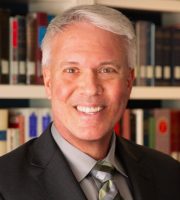
The head of Stanford University’s Department of Public Safety noted the crime rate is up around campus, but the school’s Community Board on Public Safety nonetheless remains “fiercely focused” on issues of equity.
At the CBPS’s second annual meeting last week, Chief Laura Wilson even admitted that this focus “has not gone without consequence,” The Stanford Daily reports.
Over the last year, CBPS began “anti-bias and de-escalation education programs” and “collaborated with consulting firms to remodel campus safety.” As such, Wilson said Stanford Public Safety “shifted its attention ‘from trying to prevent crime to investigating reported crimes’ by decreasing the presence of armed officers.”
This meant fewer campus police patrols around student housing.
 “We’re not quite sure what the community wants from us at this point in time, because it’s hard to stop crime if you’re not out there, contacting people,” Wilson (pictured) said. She added that “responses to crime have become more delayed due to reduced police engagement on campus.”
“We’re not quite sure what the community wants from us at this point in time, because it’s hard to stop crime if you’re not out there, contacting people,” Wilson (pictured) said. She added that “responses to crime have become more delayed due to reduced police engagement on campus.”
But to which community is Wilson referring? Is it activist groups such as the Committee for Change and Abolish Stanford … or average students who just want to pursue their studies in safety?
MORE: Stanford police abolition group beclowns itself in wake of Texas mass shooting
In addition to Chief Wilson, the conference included Stanford Center for Racial Justice Director George Brown, Riseling Group President Sue Riseling and CBPS Co-Chairs CBPS Patrick Dunkley and Claude Steele.
According to Riseling, the decline of armed officers in areas with high student activity is an important move to decrease the presence of weapons on campus, which has an associated higher risk of armed violence.
Brown agreed, noting that to build a safe and equitable policing system, police departments should limit usage of weapons as a last resort and introduce training with less focus on force. “Use the minimum amount of force required and ensure that the force will not injure innocent third parties and that the level of force is necessary and proportionate,” he told police departments at the meeting.
The issue of biases in the Stanford policing system was revisited throughout the meeting. Based on the board’s analysis of data collected from 2018 to 2020, [Steele] reported a pattern of Latinx and African American drivers being disproportionately cited more frequently.
While Steele reiterated CBPS’s focus on “discriminatory policing,” he said “a definitive conclusion still can not be drawn” and that a complete report will issued later this year.
The CBPS was created following the killing of George Floyd two years ago. Stanford President Marc Tessier-Lavigne said at the time the board was “only the first in a series of initiatives […] to confront anti-Black racism on campus and in our communities as we focus on the critical issue of racial justice.”
MORE: Stanford refuses activists’ demand to sever ties with local police
IMAGES: Kunst Bilder/Shutterstock.com; Stanford U. screencap





Please join the conversation about our stories on Facebook, Twitter, Instagram, Reddit, MeWe, Rumble, Gab, Minds and Gettr.